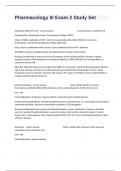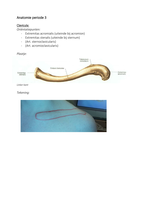Pharmacology III Exam 2 Study Set
Zidovudine (Retrovir, AZT) - correct answer Functional Class: Antiretroviral
Chemical Class: Nucleoside reverse Transcriptase Inhibitor (NRTI)
Action: Inhibits replication of HIV-1 virus by incorporating into cellular DNA by viral reverse
transcriptase, thereby terminating the cellular DNA chain
Uses: Used in combination with at least 2 other antiretrovirals for HIV-1 infection
Side Effects: Seizures, Hepatomegaly, Granulocytopenia anemia, lactic acidosis
Nursing Considerations: Assess for HIV and symptoms of HIV and the patient's baseline, register
pregnant patients at the Antiretroviral Pregnancy Registry (1-800-258-4263); do not breastfeed, is
excreted in breast milk
Black Box Warnings: Bone marrow suppression (Blood counts q2wk; watch for decreasing granulocytes,
hgb; if low, therapy may have to be discontinued and restarted after hematologic recovery; blood
transfusions may be required; viral load, CD4 counts, LFTs, plasma, HIV RNA, Serum creatinine/BUN at
baseline and throughout treatment
Efavirenz (Sustiva) - correct answer Action: Binds directly to reverse
transcriptase and blocks RNA, DNA polymerase, thus causing disruption of the enzyme's site
Uses: HIV
Contraindications: Pregnancy, hypersensitivity, moderate/severe hepatic disease
Life-threatening side effects: Suicidal thoughts/behaviors, hepatotoxicity, S-J, toxic epidermal necrolysis,
exfoliative dermatitis, immune reconstitution syndrome, QT prolongation
Nursing considerations: Do not give with benzodiazepines, ergots, midazolam, triazolam, pimozide;
assess for suicidal thoughts/behaviors; assess for serious skin reactions; Assess for signs of toxicity
(Severe N/V, maculopapular rash); Hepatotoxicity (Hold if LFTs (3.5-5) are moderately elevated in those
with liver disease)
Atazanavir - correct answer Action: Inhibits HIV protease, which prevents
maturation of the infectious virus
Uses: HIV
Contraindications: Hypersensitivity
,Life-threatening side effects: Hepatotoxicity, S-J, DRESS, lactic acidosis, hyperbillirubinemia (pregnancy,
females, obesity), immune reconstitution syndrome
Nursing considerations: Assess ALT, AST, bilirubin; Assess for lactic acidosis; Assess for serious rash
Cyclophosphamide (Cytoxan) - correct answer Action: Alkylates DNA; is
responsible for cross-linking DNA strands; activity is not cell-cycle phase specific
Uses: Leukemia, cancer of female reproductive tract, breast cancer, multiple myeloma
Contraindications: Pregnancy, hypersensitivity, prostatic hypertrophy, bladder neck obstruction
Life-threatening side effects: Cardiotoxicity in high doses, myocardial fibrosis, hypotension, hemorrhagic
cystitis, thrombocytopenia, leukopenia, myelosuppression, secondary neoplasms, pulmonary fibrosis,
interstitial pneumonia
Nursing considerations: Assess for hemorrhagic cystitis (BUN, serum uric acid, I&O ratio, report if urine
output <30 mL/hr, increase fluid intake to 3L/day); Assess for bone marrow suppression (CBC w/ diff,
platelet count (Notify provider if WBC if <2500 or if platelet count is <7500); Assess for hematuria,
guaiac, bruising or petechiae, mucosa q8hr); Assess for pulmonary fibrosis and interstitial pneumonia
(pulmonary function tests, CXR); Assess for hepatotoxicity (bilirubin, AST, ALT, LDH, jaundice, dark urine,
clay-colored stools, itchy skin, fever, diarrhea, abdominal pain, diarrhea)
Doxorubicin (Adriamycin) - correct answer Functional Class:Antineoplastic,
antibiotic
Chemical Class: Anthracycline glycoside
Action: Inhibits DNA synthesis primarily; replication is decreased by binding to DNA, which causes strand
splitting; active throughout entire cell cycle; a vesicant
Uses: Bladder, breast, lung, ovarian, stomach, thyroid cancer; Hodgkin's/Non-Hodgkin's disease; Acute
hemoplastic leukemia; myeloblastic leukemia; neuroblastomas; soft tissue/bone sarcomas
Side Effects: Irreversible cardiomyopathy, acute left ventricular failure, hepatotoxicity,
thrombocytopenia, leukopenia, anemia, necrosis at injection site, radiation recall, anaphylaxis,
secondary malignancy
Nursing Considerations: Assess renal studies (BUN, serum uric acid, urine CCr, electrolytes before and
during therapy); Report fall in urine <30mL/hr; Fever might indicate beginning infection; Assess hepatic
studies before and during therapy (Bilirubin, AST, ALT, alkphos as needed or monthly; check for jaundice
of skin and sclera, dark urine, clay-colored stools, itchy skin, abdominal pain, fever, diarrhea)
Black Box Warnings: Bone marrow depression (CBC, differential, platelet count weekly; withhold or
reduce dose of product if WBC is <1,500 or platelet count is <50,000; notify prescriber of these results);
Dysrhythmias (ECG; watch for ST-T wave changes, low QRS and T, possible dysrhythmias (sinus
tachycardia, heart block, PVCs), ejection fraction before treatment, signs of irreversible cardiomyopathy,
, can occur up to 6 months after treatment begins); Secondary Malignancy (Assess for AML and MDS,
which may occur); Extravasation (Local irritation, pain, burning at injection site; a vesicant; if
extravasation occurs, stop durg, restart at another site, apply ice, elevate extremity to reduce swelling; if
resolution does not occur, surgical debridement may be required)
Vincristine (Oncovin) - correct answer Functional Class: Antineoplastic- Misc.
Chemical Class: Vinca alkaloid
Action: Inhibits mitotic activity, arrests cell cycle at metaphase; inhibits RNA synthesis, blocks cellular
use of glutamic acid needed for purine synthesis; vesicant
Uses: Lymphomas, neuroblastoma, Hodgkin's disease, acute lymphoblastic and other leukemias,
rhabdomyosarcoma, Wilms' tumor, non-Hodgkin's lymphoma, malignant glioma, soft-tissue sarcoma
Side Effects: Seizures, paralytic ileus, hepatotoxicity, renal tubular obstruction, thrombocytopenia,
leukopenia, myelosuppression, anema, Tumor Lysis Syndrome (TLS)
Nursing Considerations: Assess for bronchospasm and Tumor Lysis Syndrome (Hyperkalemia,
hyperphosphatemia, hyperuricemia, hypocalcemia)
Black Box Warnings: Extravasation (Pain, swelling, poor blood return; if extravasation occurs, local
injection of hyaluronidase and moderate heat to area may help disperse product)
Tamoxifen - correct answer Functional Class: Antineoplastic
Chemical Class: Anti Estrogen Hormone
Action: Inhibits cell division by binding to cytoplasmic estrogen receptors; resembles normal cell
complex but inhibits DNA synthesis and estrogen response of target tissue
Uses: Advanced breast carcinoma not responsive to other therapy in estrogen-receptor-positive patients
(usually postmenopausal), prevention of breast cancer, after breast surger/radiation for ductal
carcinoma
Side Effects: Anemia, neutropenia, thrombocytopenia, New primary malignancy, leukemia, MDS/AML
Nursing Considerations: Fetal harm may be caused if used in pregnant women
Pancrelipase (Creon, Pancreaze) - correct answer Functional Class: Digestant
Chemical Class: Pancreatic enzyme
Action: Pancreatic enzyme needed for the breakdown of substances released from the pancreas
Uses: Exocrine pancreatic secretion insufficiency, cystic fibrosis, steatorrhea, pancreatic enzyme
deficiency





